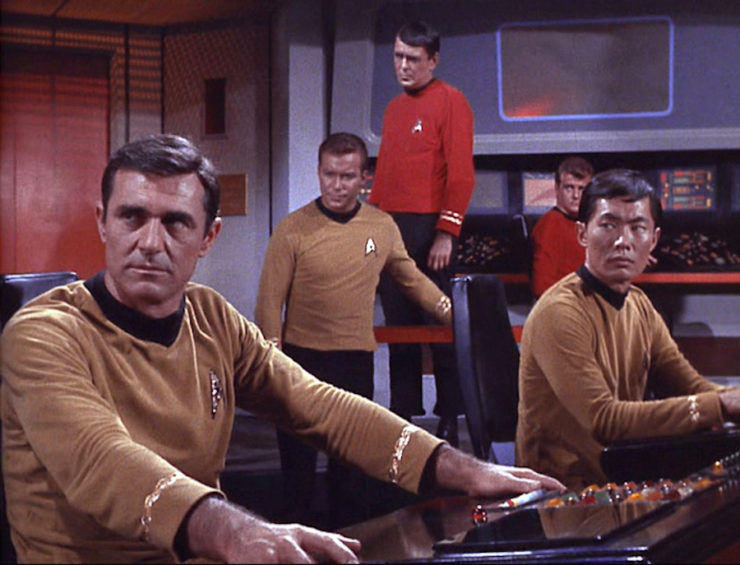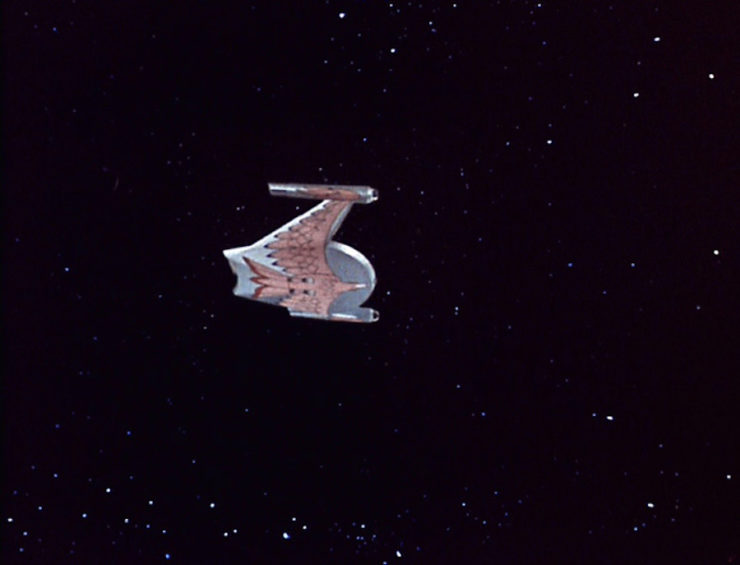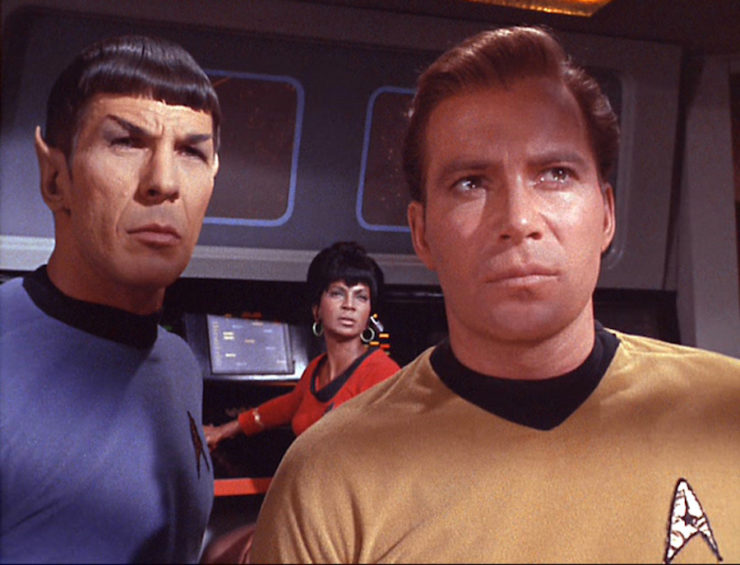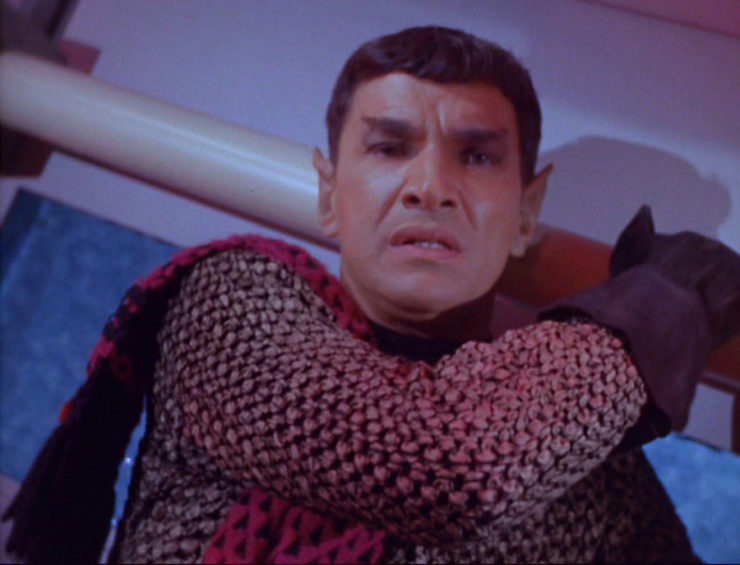Progress is measured in firsts. The first person on the moon. The first Black woman on the Supreme Court. The first country where gay marriage was legalized.
Recognizing Asian Heritage/AAPI Month, we can honour such firsts—the first Asian American senator, Hiram Fong, the first Asian woman to win the Best Director Oscar, Chloé Zhao—while also recognizing the lengths we still have to go. There has never, for instance, been an Asian American on the Supreme Court.
In pop culture, the shows that move the needle on progress are celebrated for what they depict, how they depicted it, and when it was depicted. 1966’s Star Trek is one such show: A seminal series in the history of television, with a deeply humanist vision that is still celebrated by an international and multigenerational fan base. There are, of course, aspects that have not aged well—the all-too-frequent casual sexism, for instance—but it was groundbreaking in some important ways, including the prominent inclusion of a Black woman and an Asian man in the main cast, and in its onscreen depiction of interracial relationships and sexuality.
For Generation X and all those born after, including my own millennial cohort, the series has been viewed entirely in the rear-view mirror. We were all born well after ’66. In our vernacular, the original series is spoken of as a kind of Urtext, the origin for all things Star Trek, in which we can find the seeds of so many Trek stories to come. We talk of the first time the Klingons appeared, or the first time we meet iconic characters like Khan.
“Balance of Terror,” season one, episode 14, is an episode of memorable firsts for the series: the first time we see the Enterprise in proper ship-to-ship combat. It is the first time we encounter one of the series’ recurring alien races, the Romulans. It marks the first appearance of actor Mark Lenard (who would later go on to portray Spock’s father, Sarek) in the Star Trek universe.
At first blush, the episode seems pretty straightforward: submarine warfare (heavily inspired by the 1957 WWII movie The Enemy Below) but in space. The tropes are all there, even if the aesthetic is different—for example, there’s the captain’s shipwide announcement, broadcast over echoing loudspeakers that call to mind the claustrophobic interior of a metal tube surrounded by water. Or consider the Phaser tubes being fired off with the same one-by-one precision of naval torpedo tubes.
Then there are the two captains, conducting invisible moves and countermoves, musing about strategy as they try to anticipate and outmaneuver one another. This simple conceit would likely have been enough to make “Balance of Terror” a great, highly enjoyable episode, with a tense game of chess waged between Kirk and Lenard’s Romulan commander.
But “Balance of Terror” does so much more.
The episode title is a turn on “Balance of Power,” a political concept which was especially pertinent in the Cold War era when Star Trek aired. But more than just mere wordplay, “Balance of Terror” immediately conjures to mind the underlying anxiety of mutually assured destruction.
“The other side,” according to this philosophy, is evenly matched to us, and so neither will attack. But we must maintain both eternal vigilance and eternal strength or they will see our weakness and destroy us. “Balance of Terror” peels back the awful truth underlying that philosophy.
Paranoia feeds the conflict of “Balance of Terror,” and leads to a resonant message found across every era of war. “Balance of Terror” could be a commentary on the US-Japanese conflict of WWII, the US-Soviet Cold War, or North and South Korea. Any answer would be correct. All war, everywhere, has the commonality of being sold to the public on the basis of alienation and fear.
“Balance of Terror” begins not with an attack on the Enterprise itself, but with the disruption of a happy occasion, as Kirk officiates at the start of a wedding ceremony, only to have an alert disrupt him mid-speech: an unknown enemy, attacking an Earth outpost.
Following this cold open, we’re given with an entire season’s worth of worldbuilding as Spock brings the crew up to date with an overview of the Romulan-Human conflict, which took place a century ago. Crucially, we learn that while the two sides exchanged nuclear ship-to-ship attacks, nobody even knows what a Romulan looks like. But we understand that they are the enemy, and they have attacked. Lines are drawn, and even displayed on a map for the crew—and the audience.
From there, plot-wise, the episode proceeds much as one would expect. There is the distress call from the outpost under attack, cut short as the attacking vessel dramatically annihilates them. There is the introduction of a one-off Starfleet antagonist, one Lieutenant Stiles, who immediately establishes himself as the de facto war hawk of the crew, loudly touting his military bona fides and personal grudge against the Romulans.
But the episode takes a sharp turn when the Romulan commander appears on the viewing screen.
And all eyes turn to Spock.

As an audience, we watch a character we know and love suddenly being treated with suspicion and hostility by multiple members of the crew. This is Spock. We know Spock. But now, for the sole reason of his physical appearance, Spock is treated as the enemy.
It’s especially worth noting that all of this wouldn’t work very well if the chief antagonist to Spock, Lieutenant Stiles, was a simple racist straw man, but the episode takes pains to find moments where Stiles makes reasonable points—or at least seems to.
He’s often right for the wrong reasons or finds his way to a point through faulty logic, but there are moments where his actions are justified. Sulu backs him up when Stiles asks Kirk to keep the security alert up. Spock even sides with Stiles and agrees that they press the attack.
That’s what makes the kind of hatred and bigotry that Stiles embodies so dangerous. It thrives in moments of tension and fear where violence feels right, and where escalation and security seem paramount. It’s a message made even more resonant when we realize that the true “balance” of the episode is reflected in how alike the Romulan ship is to the Enterprise.
The Romulan commander is not a warmonger. He is carrying out orders, just like Kirk—and just like him, he has a steadfast confidante in his first officer, as well as a belligerent lieutenant like Stiles who is out for blood.
When, at long last, the commander and Kirk communicate directly, in the last moments of their cat-and-mouse game, and the Romulan says “You and I are of a kind. In a different reality, I could have called you friend,” it’s not cheap sentiment. It is a deliberate point that brings home the reality that the entirety of their conflict was driven by political powers beyond their control.
It is echoed in the closing lines of the episode, as Kirk speaks with the widow of the one casualty on the Enterprise, who had been set to marry in the opening scene.
“It never makes any sense,” Kirk says. “We both have to know that there was a reason.” His troubled face after he departs, however, shows that he doubts his own words. Was there a reason? Was there any need for any of it?
What’s truly striking about this message, these troubling questions that the episode raises, is that the same questions arise when we look at the behind-the-scenes story of its production and the treatment of sculptor and prop maker Wah Chang.
If you’re a die-hard Trek fan, you may have heard the name Wah Ming Chang. Chang was an eminently talented prop maker, born in Hawaii in 1917. His family moved in the early 1920s to San Francisco and ran the Ho Ho Tea Room, a place for budding young artists. In that environment, Chang’s talents flourished and he was already a well-known artist by the age of nine, with his own show at a downtown San Francisco gallery. By 21, he had landed a job with Disney.
Chang created various iconic props and alien species for Star Trek, including the tricorder, the communicator, the Tribbles, the Gorn…and the original Romulan Bird-of-Prey, as seen in this episode.
The thing was, Chang wasn’t technically allowed to be doing any of this.

In the 1960’s, TV productions like Star Trek were supposed to be commissioning props from the official Propmakers Union. Chang was not a member of that union. A scheme was concocted by producer Robert Justman, according to Inside Star Trek: The Real Story, a book Justman co-wrote with fellow producer Herbert Solow.
Justman wrote that the union-crafted phasers that had been ordered were found to be of inferior quality. In need of some high-quality prop weapons, the production turned to Chang:
[Chang] finished everything perfectly and made several beautiful hero models of all three props. . . . That’s when the phasers really hit the fan. The studio’s propmakers complained to their union, and their union complained to the studio that the new props couldn’t be used; Wah Chang was not a union member.
[Ernest Scanlon, Desilu’s Labor Relations Director] tried to help. He suggested that Wah Chang join the union and become an ex post facto employee of the studio. . . . He could design and build everything we wanted in the future. Right? Wrong! The union wouldn’t let Wah Chang join—afraid that this talented artist might take work away from some of their members, they wouldn’t let him join.
To get around this legal trouble, Justman suggested that Wah Chang “independently build and design” the props. Then, the Trek staff would “visit” his studio, say something along the lines of “oh my, what a coincidence you have the thing we need” and would purchase it.
There were two major consequences for doing things this way.
One was that Chang would never be formally credited on-screen for his work on Star Trek. It was only through the diligence and dedication of the show’s fans that Chang was given his due years later. Through a letter-writing and word-of-mouth campaign, Chang was eventually honoured with the George Pal Memorial Award from the Academy of Science Fiction and Horror Film in 1994.
The second major consequence was that the Union soon caught wind of the fact that Desilu Productions, the company behind Star Trek, had been working with Chang in this manner. Lawyers from the Propmakers Union confronted Desilu with the receipts for Chang’s work, and forced Desilu to cancel payment to Chang for his work.
This was right around the time of “Balance of Terror.” Chang had built the Romulan helmets, the ship interior…and the Bird-of-Prey. After he was refused payment and told he might never work with the Trek team again, Chang took that Bird-of-Prey, and—according to an interview Chang gave to National Public Radio in 1982—he smashed it to pieces with a sledgehammer. Chang’s work with Star Trek, documented or undocumented, apparently ceased partway through season 2.
The reason Justman gives for the union’s refusal to allow Chang into their ranks—that they didn’t want him taking away work from their existing members—seems a bit vague, to put it mildly. We have only his word to go on; anyone else involved with the decision at the time has likely passed away, and even if that weren’t the case, it’s unlikely they would be willing to talk on the matter at length.
What we do know, however, is that racist labour laws were a fixture of both the American and Canadian legal systems for a long time. In the States, this took the form of the Exclusion Act, first implemented in 1882, which prohibited immigration of Chinese laborers. The American Federation of Labor lobbied Congress in 1902 to re-authorize the act, which was not repealed until 1943. In Canada, Chinese immigrants paid a head tax from 1885-1923, before they too were wholly excluded from immigrating, until 1947.
Of course, these kinds of racist and discriminatory practices weren’t limited to labor and immigration—it also bears mentioning that when Chang married his White partner, Glenella Taylor, they had to get hitched out of state (in Texas…somewhat ironic, given much of today’s discourse) to avoid laws prohibiting interracial marriage.

The long and short of this is that it can’t be said with absolute certainty that the Propmaker’s Union rejected Chang because of his Chinese ancestry. We do know with absolute certainty that he faced prejudice throughout his life and fought a constant battle for recognition, and that his interracial marriage was outright illegal in California at the time.
A marriage like that of my parents.
My name is Tim Ford. Had I been the son of one of my uncles on my mother’s side, I might instead be Tim Yee. As it is, I have a White family name, and a modestly White-passing appearance.
In my life, I have encountered prejudice, though I am careful to observe that such prejudice would only be worse for people who pass less easily as White. Yet in my experience, what has always struck me is how I am treated after people find out I am of mixed heritage.
There’s an almost palpable beat in that moment. It is, for me, much like that moment with Spock on the bridge, the point at which I grasp the fact that, now, for no logical reason, people are now going to look at me differently, perhaps for better, perhaps for worse.
In our global environment today, with anti-Asian hate crimes on the rise, and the mainstreaming of conspiracy theories about China and the COVID-19 pandemic, I find that I feel such moments more keenly.
Historically, the biases and preconceptions that fuel such moments have blossomed into terrible acts of discrimination like the Chinese Exclusion Act, or the forced internment of Japanese Americans during World War II. Even as we celebrate Asian Heritage Month and honour the achievements of those who’ve made a difference in some lasting way, I cannot help but think of what may lie ahead, and more tragically, what has already been lost. To ignorance, fear, and senseless prejudice.
In “Balance of Terror,” the losses are measured in lives violently ended—the deaths of the entire Romulan crew, the humans at the outpost, and Kirk’s crewman. Behind the scenes, the loss was personal and artistic. Chang’s work may not have obviously been hindered by racism, but his life certainly was, and we have no way of gauging the extent of its impact. In my own life, I know that it has affected my well-being, my family, and my outlook, both in career terms and in personal ones.
This, then, is the dark side of the “firsts” of progress: the gravity of recognizing that for every first, there were many denied, disallowed, or destroyed. Yet it is also a glimmer of hope that following that first, there may be a second, a third, and more.
“Balance of Terror” is an episode that dramatically demonstrates how judging people on the basis of their appearance is foolhardy and destructive. But it suggests that other paths are open to us, ones that allow us to recognize our common ancestry, values, and character. Freed from the influence of irrational suspicion, the thirst for colonial expansion, and the fear-based politics of hollow demagogues, we could be so much better.
In another world, we could be friends.
On balance, it is not terror that rules us. It is hope.
Tim Ford is a writer and freelance journalist based in Victoria, Canada. He has had bylines with CBC News, the Toronto Star and the National Observer, and SF&F stories with Neo-Opsis Magazine, Crossed Genres Magazine and EDGE Science Fiction and Fantasy. He also has a pitbull-corgi cross and can be found @TimFordWrites on Instagram and Twitter.










